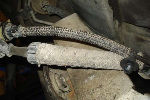MrShorty
Explorer Addict
- Joined
- December 27, 2001
- Messages
- 5,078
- Reaction score
- 20
- City, State
- Spanish Fork, UT
- Year, Model & Trim Level
- 92 XLT and '87 Bronco II
This is from a post I wrote in October. Intended as a supplement to other sources. There are several others on the net (put "Ford EEC-IV self-test" into your favorite search engine), and any good repair manual should have instructions. FWIW, the first time I did it, I was working from my Haynes manual and managed to figure it all out.
I hope this proves helpful
I hope this proves helpful
I see from another post that you didn't like www.fordfuelinjection.com's site. Here's a quick run down:
Test 1: Key On Engine Off (KOEO) test:
1) Preheat engine. Turn the key off and set up as per www.troublecodes.net/Ford. Your choice if you want to use a voltmeter, a testlight, or the CEL (aka MIL) as the output device. Test procedure is the same in all cases, it's just a matter of output device.
2) Turn key on. Relays will click, fuel pump will run briefly as the computer checks various parts of the system for errors (This will be the source of the KOEO codes to be explained shortly).
3) Fast codes are output. I've seen a couple of different descriptions of what information is contained herein. In any case, all you may see is a brief movement of the needle/weak flash of the light to indicate the fast codes have been output.
4) KOEO codes are output. These are codes set during the aforementioned KOEO test. KOEO codes are output, then repeated. Note that if no faults are detected, the computer will output a 111 system pass code. I've seen several attempts to describe code output format, all of which seemed more confusing until you actually try it. My best advice is to try it and see what happens.
5) After the last KOEO code is output the second time, there's about a 6 second pause, a single pulse/flash (the separator pulse) and another 6 second pause. Then the continuous memory (CM) codes are output. CM codes follow the same format as the KOEO codes, and are repeated twice. CM codes are codes set during normal engine operation (often associated with a lit check engine light) and stored for retrieval.
6) Turn key off and disconnect to complete test.
7) If you want to clear CM codes without clearing Keep Alive Memory (KAM), repeat test, disconnecting the STI-SIG RET jumper wire anytime during KOEO/CM code output.
8) If you leave the key on and test connected after last CM code is output, you can enter a test mode called output state test mode. Press the throttle to enter output state test. In this test mode, each press of the throtlle will trigger the computer to cycle various solenoids/controls (transmission solenoids, EGR regulator solenoids, etc.). This mode can be used to test these components.
test 2: Key On Engine Running (KOER) test.
1) Preheat engine. Setup same as for KOEO test.
2) Start engine.
3) Engine id is output. This is a code to indicate the number of cylinders the computer is set up for, and is half the number of cylinders. So you should get three flashes/pulses for a 6 cylinder engine (2 for a 4 cylinder, 4 for 8 cylinders).
4) Immediately after engine ID is output, press brake so computer can test BOO switch. (FYI, other applications have a power steering pressure switch that is tested at the same time by turning the steering wheel. Not necessary on Explorers).
5) Engine will go through a low speed and then a high speed test. These tests will take up to a couple of minutes. During this time, if you want, you can test timing advance with a timing light. Computer will advance timing a fixed 20+Base BTDC. Base is almost always 10 BTDC, so you should see about 30 BTDC timing.
6) At end of KOER test, as engine spins down, you will get a pulse/flash for the dynamic response test (DRT test, aka "goose" test). Perform a brief wide open throttle.
7) KOER codes are output.
8) Turn engine off and disconnect to end test.
9) On sequential fuel injected models, the computer can perform a cylinder balance test. After step (7), press the throttle to enter the cylinder balance test. During this test, the computer will disable each fuel injector one at a time while monitoring idle speed. Any cylinder that doesn't effect the idle speed will be indicated by a code at the end of the test. (Disclaimer: I don't have SEFI, so I've never tried this test. I don't know how well it works.)
Is that easier to follow?











